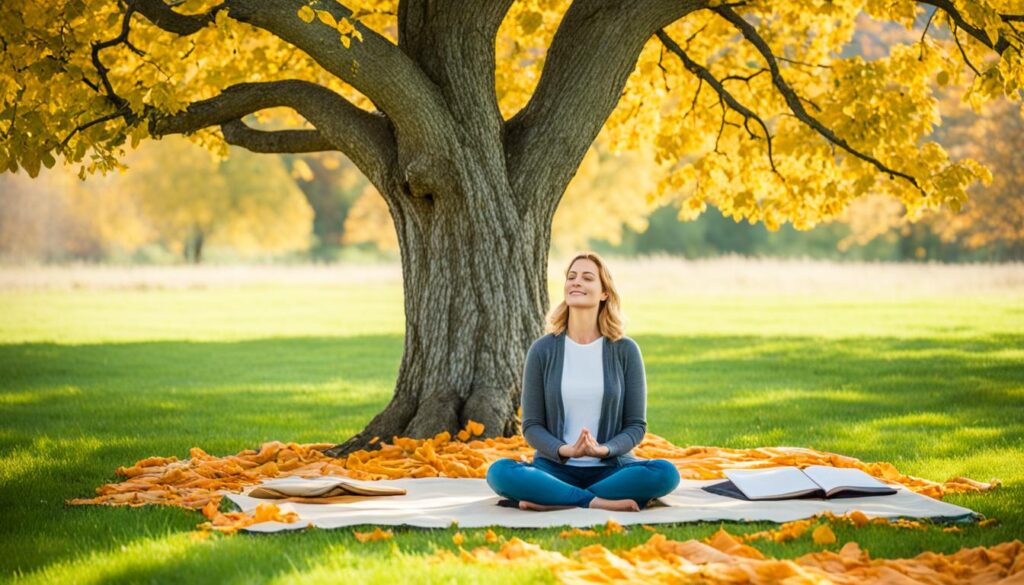Start Gratitude Meditation: 6 Simple Steps Today

Life’s daily grind can make us forget the good things around us. Gratitude meditation helps us pause and appreciate life’s positives. It’s a simple yet powerful tool for boosting well-being.
This guide offers six easy steps to start gratitude meditation today. It’s perfect for beginners and experienced meditators alike. We’ll share practical tips, including a 2-minute gratitude meditation script.
These tools will help you add this practice to your daily routine. By the end, you’ll be ready to foster a more positive outlook on life.
Key Takeaways
- Gratitude meditation is a simple yet powerful practice for enhancing well-being and cultivating positivity.
- Consistency is crucial for reaping the benefits of gratitude meditation, with daily practice recommended.
- Setting clear intentions before meditation can help focus the mind and energy during the practice.
- Combining gratitude meditation with other mindfulness practices can amplify its positive effects.
- Expressing gratitude for oneself during meditation is important for self-compassion and self-love.
Understanding the Power of Gratitude Meditation
Gratitude meditation cultivates thankfulness and appreciation. This mindfulness practice focuses on positive aspects of our lives. It greatly impacts our mental, emotional, and physical well-being.
What is Gratitude Meditation?
Gratitude meditation directs attention to things you’re thankful for. These can include loved ones, health, or simple everyday pleasures. This practice shifts our mindset from negative to positive thoughts.
It aims to create a state of contentment and peace. By focusing on positives, we can change our perspective.
Benefits of Gratitude Meditation
Regular gratitude meditation offers many benefits. Research has shown its positive effects on various aspects of life.
- Improved mental health by reducing symptoms of depression and anxiety
- Enhanced sleep quality and reduced stress levels
- Increased feelings of happiness and optimism
- Stronger immune function and better physical health
- Deeper connections and more fulfilling relationships
Gratitude meditation can rewire the brain. It promotes emotional resilience, compassion, and memory. Studies show it can increase gray matter in key brain areas.
“Gratitude can lower blood pressure, improve heart health, boost immune function, and encourage healthy habits such as exercise and proper diet.”
Expressing gratitude often leads to a more positive outlook. Smiling, saying thank you, and keeping a gratitude journal can help. These actions trigger feelings of gratitude more frequently.
Gratitude meditation can be a powerful daily tool. It helps build positivity, resilience, and contentment. This practice can improve mental health and relationships.
It also helps find more joy in everyday life. Consider exploring this beneficial practice for yourself.
Creating a Dedicated Meditation Space
A personal sanctuary can greatly improve your gratitude meditation practice. This space should be peaceful, cozy, and free from distractions. It should inspire calmness and mindfulness.
Your meditation area doesn’t need to be big or fancy. A quiet corner in your room or garden can work well. The key is finding a spot that feels right and promotes relaxation.
Decorate with items that mean something to you. Use a favorite photo, artwork, or keepsake. These will help set the mood for your practice.
Add soothing elements to your space. Soft lighting, calming colors, or gentle nature sounds can help. These cues can quiet your mind and deepen your mindfulness.
Your meditation space should reflect your personal taste. Try different setups until you find one that feels right. It should inspire peace and gratitude.
| Element | Benefit |
|---|---|
| Soft Lighting | Promotes a calming, soothing atmosphere |
| Calming Colors | Can help to reduce stress and anxiety |
| Gentle Nature Sounds | Helps to focus the mind and enhance relaxation |
| Personal Mementos | Adds a sense of meaning and connection to the space |
A dedicated meditation space sets the stage for deeper gratitude practice. This sanctuary will become a haven for your mindfulness journey. It will help you appreciate the present moment and life’s blessings.
“Your sacred space is where you can find yourself again and again.” – Joseph Campbell
Focusing on Your Breath
Breath focus is key in mindfulness and gratitude meditation. It anchors your attention to the present moment. This practice helps you develop deeper awareness and appreciation.
Start your meditation by taking slow, deep breaths. Inhale through your nose, feeling your lungs fill with air. Then, exhale slowly through your mouth, letting go of tension.
Breathing Techniques for Mindfulness
Specific breathing exercises can boost your gratitude meditation. Try the 4-7-8 breathing technique. Inhale for 4 seconds, hold for 7, then exhale for 8.
Box breathing is another helpful method. Inhale for 4 seconds, hold for 4, exhale for 4, and hold for 4. This technique can reduce stress and promote relaxation.
“Breath is the bridge which connects life to consciousness, which unites your body to your thoughts. Breathing is the greatest tool we have for well-being and balance.” – Thich Nhat Hanh
Explore different breathing techniques in your gratitude practice. Find the ones that work best for you. Regular breath focus helps create a mindful state.
This allows you to fully experience the present moment. You’ll be better able to appreciate life’s blessings.
Reflecting on Gratitude
Let’s focus on what you’re grateful for. Think about positive emotions and experiences in your life. These could be a loving family, a good friend, or nature’s beauty.
Try to really feel the gratitude in your heart. With practice, you’ll notice a shift in your mindset. Your goal is to grow a sense of gratitude.
A 2-Minute Gratitude Meditation Script
Here’s a simple 2-minute gratitude meditation script to get you started:
- Inhale deeply, filling your lungs with air.
- As you exhale, think of one thing you are grateful for.
- Hold onto that feeling of gratitude as you inhale again.
- Repeat this process for two minutes.
Regular gratitude practice can boost your immune system and improve sleep. It can also make you feel more optimistic and generous. Taking time to reflect on the positive can enhance your overall well-being.

“Gratitude is the healthiest of all human emotions. The more you express gratitude for what you have, the more likely you will have even more to express gratitude for.” – Zig Ziglar
6 simple steps to start practicing gratitude meditation today
Gratitude meditation can transform your daily routine. It improves mental health, sleep, and reduces stress. This practice boosts happiness and well-being. Here are six simple steps to get started:
- Create a Calm Meditation Space: Find a quiet, comfortable area in your home. Make it distraction-free. This space will help you settle into mindfulness easily.
- Set an Intention: Take a moment to set an intention before meditating. It could be “I’m grateful for my health” or “I’ll focus on positives today.”
- Focus on Your Breath: Start with deep breaths. Let your body relax and mind become present. This mindfulness practice helps you stay focused during meditation.
- Visualize and Express Gratitude: Think of things, people, or experiences you’re grateful for. Express your gratitude mentally. Feel the positive emotions linked to your appreciation.
- Acknowledge Your Strengths: Reflect on your accomplishments, skills, and positive qualities. Appreciate the unique gifts you offer to the world.
- Reflect on Your Experience: After meditating, journal about your experience. Note any insights, emotions, or changes you noticed during practice.
Consistency is key in daily practice of gratitude meditation. Start with 5-10 minutes per day. Gradually increase the duration as it becomes natural.
By following these steps daily, you’ll experience the benefits of this practice. It will become part of your personal growth routine.
“Gratitude is not only the greatest of virtues but the parent of all others.” – Cicero
Making It a Daily Habit
Consistency unlocks gratitude meditation’s full potential. Make it part of your daily routine to experience its benefits. Choose a specific time each day for your practice.
Tips for Consistency
Your meditation doesn’t need to be long. Even a few minutes daily can make a difference. As you get comfortable, gradually increase your meditation time.
- Be patient with yourself. Establishing a new habit takes time and practice.
- Utilize strategies like journaling or guided meditations to enhance your gratitude practice and maintain consistency.
- Surround yourself with positive influences that reinforce the importance of cultivating daily habits and personal growth.
- Celebrate your progress and milestones along the way to stay motivated and engaged with your meditation routine.
Regular gratitude meditation can transform your life. It positively impacts your well-being and helps build positive habits. Embrace this practice to unlock its power.
“Consistency is the key to unlocking the full potential of your gratitude meditation practice. Stick with it, and you’ll be amazed by the positive changes you’ll experience in your life.”
Gratitude Meditation for Better Sleep
Gratitude meditation can boost your sleep quality. It helps you relax by focusing on positive thoughts before bed. This practice creates a calm mindset for restful sleep.
Studies show gratitude meditation improves sleep for many adults. Over 40% of people with sleep issues saw major improvements. A study of 400 adults revealed significant benefits to sleep and well-being.
Try a short gratitude meditation before bed. Think about positive moments from your day. Be thankful for them. This simple act can prepare your mind for sleep.
Over time, gratitude meditation may enhance your sleep quality. You might wake up feeling more refreshed and positive. This practice can greatly impact your overall health and wellness.
| Benefits of Gratitude Meditation | Impact on Sleep Quality |
|---|---|
| Increased happiness and optimism | Decreased time to fall asleep |
| Improved mental health and well-being | Increased sleep duration |
| Strengthened personal relationships | Improved sleep efficiency |
| Reduced physical health problems | Enhanced sleep restoration |
Adding gratitude meditation to your bedtime routine can improve sleep quality. It promotes relaxation and mental wellness. Start small, be consistent, and watch this simple practice transform your life.
Strategies for Maintaining Your Practice
Gratitude meditation can be tough to keep up when life gets hectic. But simple strategies can help make it a regular habit. This practice boosts personal growth, mental wellness, and stress management.
Set a regular time for your practice. Pick a specific moment each day, like morning or bedtime. Use a gratitude journal to record thoughts and track progress over time.
Be patient with yourself on tough meditation days. Try guided meditations or meditation apps for structure and support. Enjoy the process and cherish each step of your gratitude meditation journey.

Consistency is crucial for maintaining a gratitude meditation practice. Even one session can boost gratitude and bring many benefits. These include less depression, better sleep, and improved well-being.
By using these tips daily, you can make gratitude meditation a lasting part of your life. You’ll reap rewards for your mental wellness and personal growth.
Conclusion
Gratitude meditation can change how you see life. It helps you focus on the good things around you. This practice builds contentment and happiness that lasts beyond your meditation time.
Consistency is key for successful gratitude meditation. Start with a few minutes daily. Soon, you’ll notice its effects on your mental wellness and emotions.
Studies show gratitude meditation improves mood and reduces anxiety. It also enhances resilience and promotes better sleep. Practicing gratitude increases happiness, compassion, and trust.
These benefits positively impact your personal growth and relationships. Begin your gratitude meditation journey today. Make it part of your daily routine.
You can develop a more positive mindset through this simple practice. Enjoy the rewards of appreciation and thankfulness. Nurture your well-being with gratitude meditation.
FAQ
What is gratitude meditation?
Gratitude meditation is a mindfulness practice that focuses on cultivating thankfulness. It involves reflecting on things you appreciate in life. This could be family, food, or simply being alive.
What are the benefits of gratitude meditation?
Gratitude meditation can improve mental health and reduce depression and anxiety. It enhances sleep quality and helps manage stress. The practice also boosts happiness and promotes physical health.
Research shows it can improve immune function and lower blood pressure.
How do I create a dedicated meditation space?
Create a quiet, comfortable space free from distractions for your gratitude meditation. Decorate it to inspire peace and tranquility. Include items that have special meaning to you.
What are some breathing techniques for gratitude meditation?
Focusing on your breath helps anchor your mind in the present moment. Start with deep breaths, inhaling slowly through your nose. Hold for a moment, then exhale through your mouth.
Try the 4-7-8 technique: inhale for 4 seconds, hold for 7, exhale for 8. This exercise sets the stage for gratitude meditation.
Can you provide a sample gratitude meditation script?
Here’s a simple 2-minute gratitude meditation script: Inhale deeply, filling your lungs with air. As you exhale, think of one thing you’re grateful for. Hold that feeling of gratitude as you inhale again. Repeat for two minutes.
How can I make gratitude meditation a daily habit?
Consistency is key in meditation. Set aside a specific time each day for your practice. Choose morning, lunch break, or before bed. Even a few minutes daily can make a difference.
How can gratitude meditation help with sleep?
Gratitude meditation can improve your sleep by focusing on positive thoughts before bed. This creates calm and relaxation, promoting better rest. Include a short gratitude meditation in your bedtime routine.
What strategies can I use to maintain my gratitude meditation practice?
Use a journal to record your reflections and track your progress over time. Be patient with yourself on difficult meditation days. Try guided meditations or apps for structure and support.




